The Strong Man (1926)
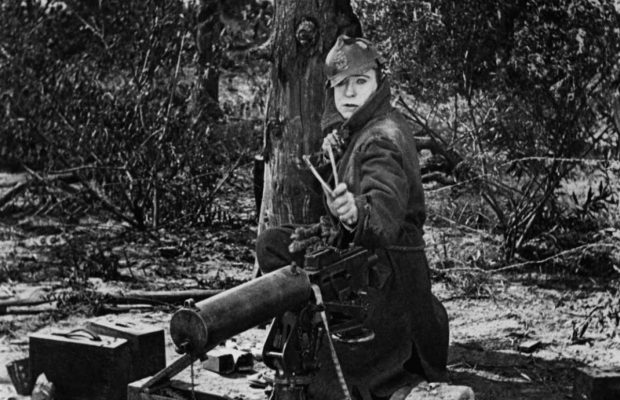
Toronto Film Society presented The Strong Man (1926) on Monday, December 8, 1952 as part of the Season 5 Main Series, Programme 4.
FOURTH EXHIBITION MEETING – FIFTH SEASON
Monday, December 8, 1952 8.15 p.m. sharp
Royal Ontario Museum Theatre
NOTE: The Theatre door will open at 8.00 p.m.
Members who arrive early will thus have
a choice of seats
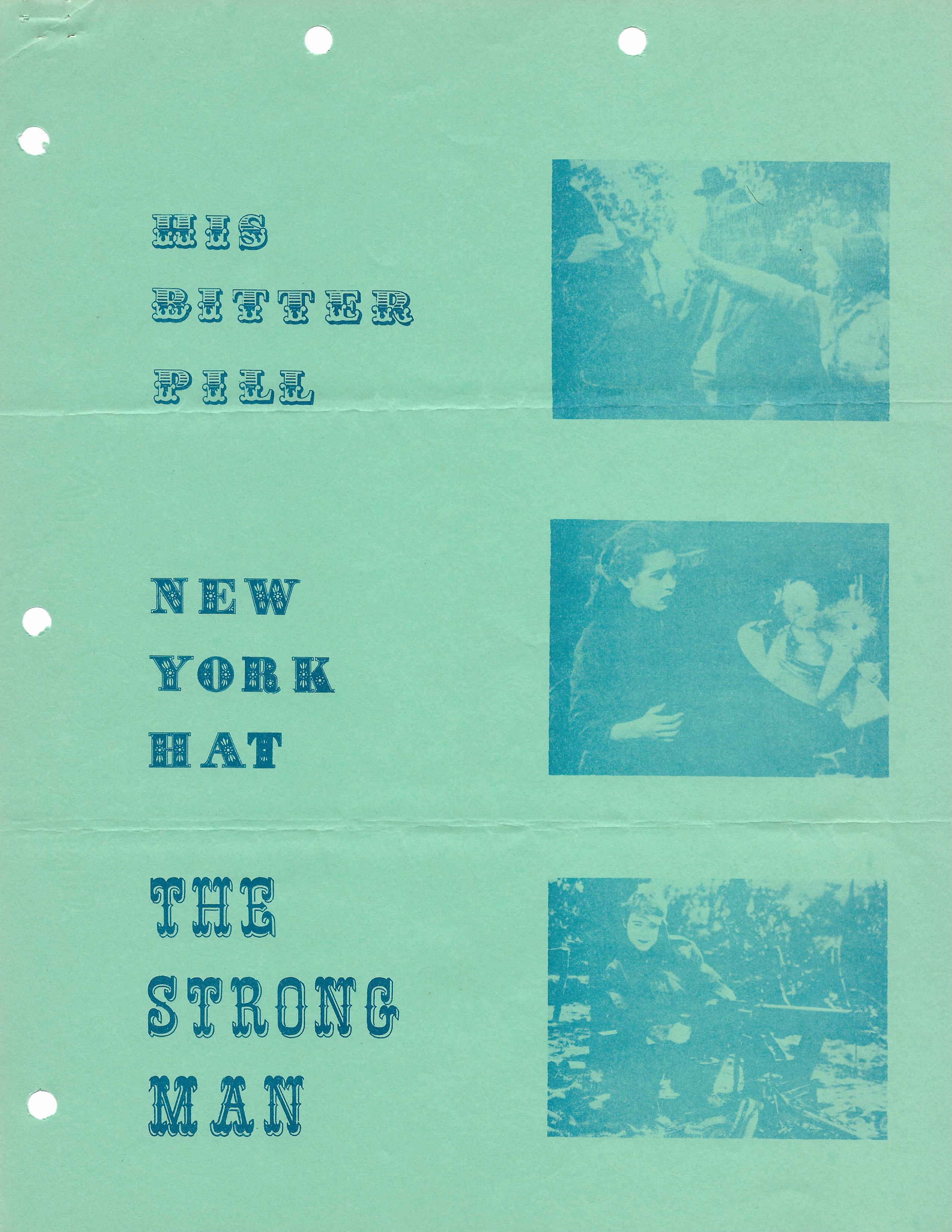
SCREEN COMEDY
The term “comedy” in the cinema has always retained an allusion to clowning, improvisation, magic and the whole repertory of fairs, circus, vaudeville and charades… A true film comedy is conceived in terms of a non-existent universe of fantasy and frolic.
One of the purest types of film, slapstick comedy originated in the little comic incidents of the primitive cinema and early “chase” films from France. It developed after 1905 under the French comedian, Max Linder, who introduced the visual surprises which are to screen comedy what “gags” are to vaudeville comedians.
Mack Sennett, the master of American film comedy, studied Linder closely. When in 1912 Sennett became a director for Keystone, he carried slapstick to its final form. Despite his influence on Chaplin and on René Clair, Sennett’s talent has always been underestimated. Slapstick today is decadent and people remember it, erroneously, as a lot of meaningless pie-throwing and rushing about. It was, instead, an ordered madness, a high form of cinematic play improvised with an instinctive grasp of visual rhythm and of tempo. (Museum of Modern Art)
His Bitter Pill U.S.A. 1916 Approx. 7 mins
PRODUCED by: Mack Sennett
CAST: Mack Swain, Louella Maxam, Ella Haines, Edgar Kennedy
In 1916, the Western film was in its heyday and Bill Hart the idol of countless thousands. Since nothing was sacred to Mack Sennett and his irreverent comedians, a skit on the Western film was hardly to be resisted. Sennett’s unerring instinct for the genuinely comic hero guided him away from his customary slapstick towards a delicate but devastating kind of satire. His Bitter Pill is apparently a genuine Western, complete with heroic sheriff, villain, robbery and hard riding: but it is seen through an ingeniously distorted lens and the values are unerringly overemphasized or misplaced. The subtitles are pure mockery. Mack Swain, who does a delicious bit of work as the hero, was an eminent member of the Keystone comedians, and afterwards played with Chaplin in his The Gold Rush and other films. (MMA)
The New York Hat U.S.A. 1912 Approx. 12 mins
PRODUCED by: the Biograph Co.
DIRECTED by: D.W. Griffith
PHOTOGRAPHED by: G.W. Bitzer
ORIGINAL STORY by: Anita Loos
CAST: Mary Pickford and Lionel Barrymore
Among the extra players are Lillian and Dorothy Gish, Mack Sennett, Jack Pickford, Robert Harron, Mae Marsh
A girl with long curls, at first anonymous like all Biograph players but afterwards canonized as Mary Pickford, responded curiously to Griffith’s direction. Her gestures were small, drawn-out but expressive; there was warmth and sincerity in the parts she played. Even today, under the mawkish sentiment, the period morality and clothes, this little film remains singularly fresh and moving. Mary gives herself a half-disparaging look in the mirror, arranges one glove to look like a pair, and trips hopefully outdoors. This is neither literature nor theatre: it is pure film, of the kind we associate with Chaplin, yet made a year before Chaplin abandoned vaudeville for the screen. This close approach to the character, these details which illuminate a whole mood and have universal significance are among Griffith’s finest contributions to the cinema. (MMA)
Works of Calder U.S.A. 1950 20 mins
PRODUCED AND NARRATED by: Burgess Meredith
PHOTOGRAPHED AND DIRECTED by: Herbert Matter
MUSIC by: John Cage
NARRATION by: John Latouche
This is a poetic, almost abstract interpretation of an artist’s work rather than a simple document. Rhythmically composed sequences suggest a parallel between familiar forms and movements in nature and the movements in Alexander Calder’s mobiles. The color, the motion, the gaiety of Calder’s work is eminently suited to the color film medium. (MMA)
Calder is an American sculptor, son and grandson of sculptors. He was born in Philadelphia in 1898; pursed engineering for four years in various forms; studied painting in New York and went to Paris in 1926, where he began making wire toys and sculptures; he joined the “Abstraction-Creation” group in 1931. Inspired by the abstractions of Piet Mondrain, he evolved free and balanced creations of coloured metal and wire to move and swing with the least breath of air; his mobiles were exhibited for the first time in 1932. Calder lives in Connecticut.
INTERMISSION
10 minutes
The Strong Man (1926)
WRITTEN AND DIRECTED by: Frank Capra
SCRIPT by: Hal Conklin
PHOTOGRAPHED by: Elgin Lessley and Glenn Kershner
Cast: Harry Langdon, Gertrude Astor, William K. Mong, Robert McKim, Priscilla Bonner.
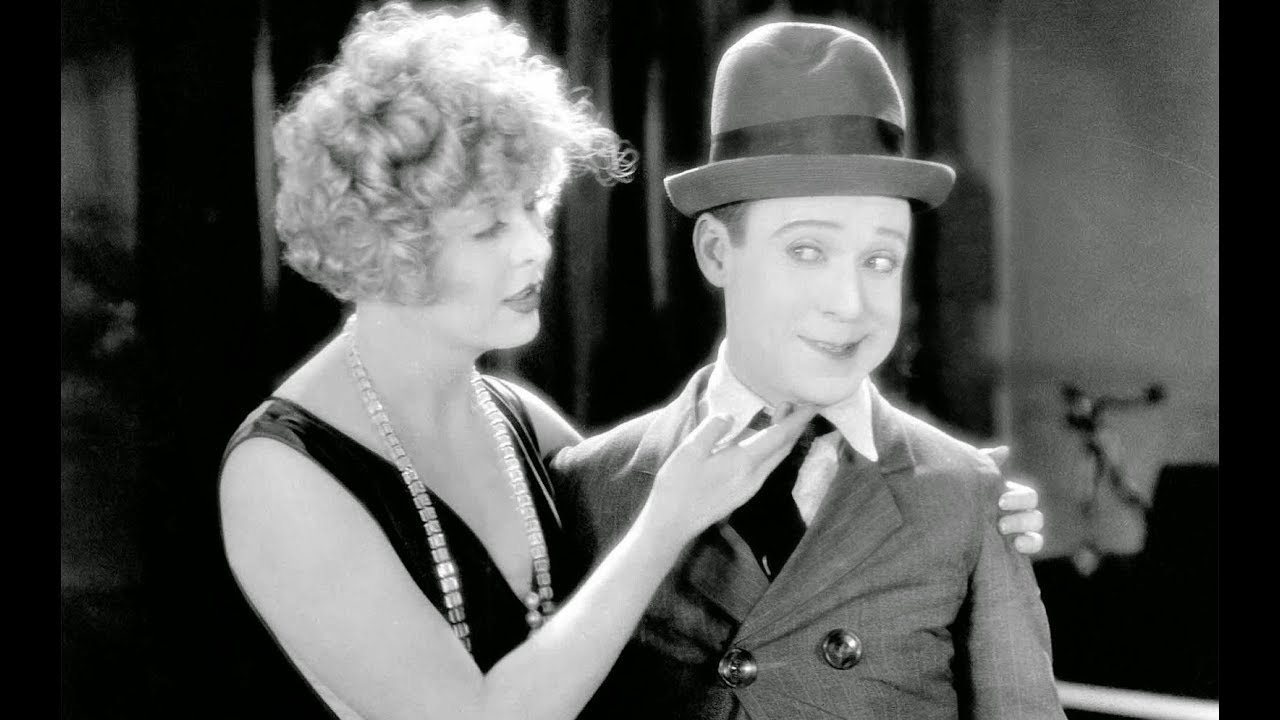
Screen comedy was in its glory in the years between 1912 to 1930, as practiced by the employees of Mack Sennett and by the four most eminent masters: Charlie Chaplin, Harold Lloyd, the late Harry Langdon and Buster Keaton.
Chaplin and Keaton and Lloyd were all more like each other, in one important way, than Harry Langdon was like any of them. Whatever else the others might be doing, they all used more or less elaborate physical comedy; Langdon showed how little of that one might use and still be a great silent-screen comedian. In his screen character he symbolized something as deeply and centrally human, though by no means as rangily so, as the Tramp. There was, of course, an immense difference in inventiveness and range of virtuosity. It seemed as if Chaplin could do literally anything, on any instrument in the orchestra. Langdon had one queerly toned, unique little reed. But out of it he could get incredible melodies.
Like Chaplin, Langdon wore a coat which buttoned on his wishbone and swung wide below, but the effect was very different: he seemed like an out-sized baby who had begun to outgrow his clothes. His walk was that of a child which has just gotten sure of its feet, and his body and hands fitted that age. His face was kept pale to show off, with the simplicity of a nursery-school drawing, the bright, ignorant, gentle eyes and the little twirling mouth. Twitchings of his face were signals of tiny discomforts too slowly registered by a tinier brain; quick, squirty little smiles showed his almost prehuman pleasures, his incurable premature trustfulness. He was a virtuoso of hesitations and of delicately indecisive motions.
He was as remarkable a master as Chaplin of subtle emotional and mental process and operated much more at leisure. There was also a sinister flicker of depravity about the Langdon character, all the more disturbing because babies are premoral.
Langdon came to Sennett from vaudeville. The minute Frank Capra, one of Sennett’s gag men saw him, he begged Sennett to let him work with him. For more than a year Capra was chiefly occupied with writing gags for Langdon’s two-reelers, finally working out a definite characterization for the comedian. He endowed him with all good qualities except sense. Langdon became a sainted moron in a world of miscreants. His only ally was Providence, which kept intervening with masterful gags to rescue him from desperate situations. Leaving Sennett to make feature-length pictures for First National, Langdon took Capra with him.
Langdon’s magic was in his innocence, and Capra took beautiful care not to meddle with it. The key to the proper use of Langdon, Capra always knew, was the “principle of the brick.” “If there was a rule for writing Langdon material,” he explains, “it was this: his only ally was God. Langdon might be saved by the brick falling on the copy, but it was verboten that he in any way motivate the brick’s fall.” Langdon became quickly and fantastically popular with three pictures, Tramp, Tramp, Tramp, The Strong Man and Long Pants: in both popularity and critical acclaim he was for a few years the peer of Chaplin, Lloyd and Keaton. Then he went downhill. “The trouble was,” Capra says, “that high-brow critics came around to explain his art to him”; the intelligentsia convinced Langdon that he should exploit the pathos inherent in his screen character rather than the broad comedy which had won him a following. Capra disagreed on the ground that Langdon’s pathos was a by-product of the comic predicaments which overwhelmed him. Langdon fired him. Langdon made two more pictures with high-brow writers; then First National cancelled his contract. He was reduced to mediocre roles and two-reelers which were more rehashes of his old gags. “He never did really understand what hit him,” says Capra. “He died broke (in 1944). He was the most tragic figure I ever came across in show business.”
The Strong Man, both written and directed by Capra, was his first feature-length film.
Edited from Comedy’s Greatest Era by James Agee
Life, Sept. 5, 1949
and Frank Capra by Richard Griffith
New Index Series No. 3 – B.F.I.
Piano arrangement and accompaniment to His Bitter Pill,
The New York Hat and The Strong Man
by Ruby Ramsay Rouse
MEMBERS’ EVALUATIONS
Rubens proved one of the Society’s most controversial offerings, provoking lively and heated reactions. Excerpts follow:
Pro: “Liked it very much; heretofore I did not appreciate Rubens and wish I had seen the film before seeing his pictures”—“Excellent, very interesting and powerful, but would have liked a longer look at portraits”—“Will be difficult to forget; makes a demand on the viewer who if he sticks it out is rewarded with a staggering overall effect; couldn’t have been achieved in a neat little 15 minute art film; music effective, moving camera much better handled than in The Titan; but the crazy dance of animated canvases at the end is hysterical!”—“Extremely valuable educationally; photography excellent; but perhaps defeats own ends by overdoing; much too long, narration thin, music gruesome”—“Interesting, lively quite superior art film, which moves, a great virtue; but too long, and could quarrel with 70% of editing devices”—“A film of great fascination, beauty, and vigorous values artistically; if it had ended after the great climax of the drama of Christ, I would say one of the greatest films ever made; but the rest – such anti-climax!”—“Enjoyed it (with moderation); comparisons with other painters very fascinating”—“Visually often splendid and striking; appreciated with opportunity to see paintings; but commentary inane to point of vulgarity and film lacks unity; episodic, scattered”—“Quite rousing, well filmed, excellent instructional film for average gallery visitor; liked director’s ability to see and present clearly many facets of each picture; but much tedious reiteration”—“Superb film presentation of difficult problem, but composition sequences a little repetitive”—“Good; liked the attempt to show the relations between Rubens’ works, but disliked commentary”.
Con: “For those who appreciate both painting and film, a double betrayal in attempt to evaluate one art by means of another; paintings documents in themselves, best studied in their own happy medium; bigoted, schoolroom concepts of composition; split screens, with movement, disconcerting, therefore ineffective; not a documentary film; an attempt to animate the inanimate, twice removed from Rubens’ original intent; films about art are intensely boring; but liked impeccable use of dissolves”—“If only they showed his painting without horrible, inane dialogue and repetitious circles; but liked closeups and concentration on paintings”—“Too long, too repetitious, music disturbing, too many circles, movement too fast; original idea good but not carried out very well”—“Tedious and too long; liked movement”—“Tiresome, ruinous, cacophonous; only Society film ever to force us out”—“Trash!”—“Enunciation and pronunciation of commentary; pointlessness of camera tricks; insane drone of music; quite the beastliest ever!”
COMMENTS ON SHORTS:
A Phantasy: “Silly drivel”—“Visuals elementary and ‘old hat’ for McLaren today, not dynamic; but mixture of synthetic sound with saxophone most impressive”—“Pleasant ‘doodling’ but meaningless except possibly to a psychologist”—“Pretty to look at but actually nothing but a sort of symbolic doodling”—“A sheer joy; only lateness of hour prevented me seeing it again; delightfully whimsical but demands close attention and concentration”—“I’ve had enough McLaren though admire him technically”—“Excellent; stimulates imagination”—“McLaren is going in an unhealthy direction”—“Excellent! Reminiscent of Dali, Tanguy; takes its place beside the work of all artists, regardless of nationality.”
Critic and Film #3 (Odd Man Out): “Fascinating but maddening as I hadn’t seen film; hope to some day”—“Interesting experiment spoiled by soundtrack”—“Stimulating analysis”—“More of these, please”—“Outstandingly good”—“Really enjoyed it”—“Very instructive, excellent, more would be welcome”—“The sort of thing the interested film-goer wants to see; puts over an analysis in a way he cannot normally himself make”—“Despite limited means of production, a good presentation; superior to Rubens because analysis was pointed and dealt with its own medium”—“Pretentious”.
The Living Stream: “Unexciting”—“Magnificent visuals; what a print!”—“Excellent both in conception and photographic execution; spoiled by narration’s cheap propaganda and ridiculous sentimentality!”—“Very lovely but cannot approach in mood the best of work of Jennings whose technique has the necessary fluidity”—“Very fine”—“Beautiful to look at but very disjointed”—“Dull”.
One member thought the shorts too many and varied, would have preferred to see Rubens alone. Another remarked: “I wouldn’t dare miss a Film Society evening; never know what’s going to happen next. This season so far is particularly intriguing, each programme offering a different approach to film. Keep it up! But members stampeding before film has ended are annoying to say the least. This is a FILM SOCIETY!
CURRENT FILM NOTES
Mandy, in spite of some unfortunately banal elements in the adult part of the story, is a remarkable film about a deaf-mute child and her training, along with others, to comprehend and to speak. A less publicized picture about childhood, When I Grow Up, portrays a young boy’s experiences and relations with his elders with unusual understanding and sensitivity. Another unheralded and modest production that happens to be one of Hollywood’s best efforts of the year is Shadow in the Sky, the story of a battle-shocked veteran’s rehabilitation told without falsity or strain; absorbing, moving, put together with sure skill and acted with complete conviction. Lastly, Italy’s The Difficult Years traces with humanity, humor and unusual political honesty, the fortunes of a middle-class family through Fascism, war and liberation.
George G. Patterson

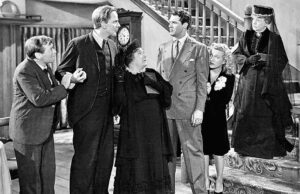
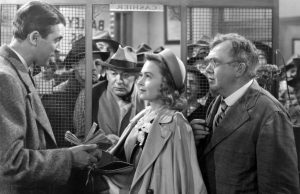







Leave a Reply